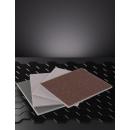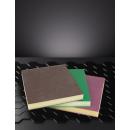Dry body sanding paper

Dry body sanding paper for cars and motorbikes
︾
Description of dry abrasive papers for bodywork :
Which dry sanding paper should I choose?
Whether you're a DIY enthusiast or a bodybuilder, we all know that sanding is an essential step in achieving a smooth surface. But to get a smooth, clean surface, you need quality equipment, and not all sanding papers are created equal. Carross offers you a whole range of 4CR brand sanding sheets suitable for various types of work on car bodywork. Many of our products can be used by hand or on a sander to suit all your needs. At your Carross shop, you'll find sheets with various grits (from 80 to 2500) for sanding different bodywork surfaces: flat or curved. Everything you need to obtain a perfect surface is available at Carross! Find out more about dry sanding paper in the following pages.
What is dry sandpaper?
First of all, you should know that some abrasive papers are suitable for roughing work, while others are more dedicated to bodywork finishing. So you need to know exactly which type of abrasive paper is best suited to which type of surface. Sanding paper is also known as sandpaper. Sanding paper can be made from different materials. There are natural abrasives, made from emery, flint, glass or garnet. There are also synthetic materials such as aluminium oxide or silicon carbide, for example. Like sanding discs (which you'll find in our category dedicated to sanding discs), abrasive paper is classified by grain type.
What is the difference between dry sanding and wet sanding?
Dry sanding and wet sanding are different stages in the sanding process. Dry sanding is generally recommended before wet sanding. Combining the two techniques ensures that any defects are properly evened out and that the bodywork is uniform. Wet sanding will remove the scratches left by dry sanding. Sanding with water is a process that can be combined with water or a lubricant, for example. The material of the papers used is specifically adapted for use on non-dry surfaces. Waterproof abrasive sheets found on the Carross site start at 220 grit and go all the way up to 2500 grit. Dry sanding sheets range from extra fine to ultra fine. If you're looking for wet abrasive paper, you'll find this type of product at this address.
Precautions before using abrasive paper
It's often forgotten, but bodywork or applying car paint can be a source of danger! Sanding paper is no exception. There may be fewer risks than when using a drill or sander, but you still need to be careful! To help protect you, Carross offers a range of equipment that will come in handy when you're in the middle of a dangerous operation. Gloves to protect against cuts, goggles and a mask to protect your lungs against dust... Your health must be your priority! You'll find all this protection in the Carross online shop.
Different types of abrasives
You'll find all the different types of abrasives you need to get the best final body paint at Carross! The Carross online shop offers a wide range of Abrasive discs, abrasive rollers and universal sanding discs. We also provide a responsive and competent sales department to help you choose the best possible abrasive for your bodywork or car paint. Don't hesitate to write to us or give us a call!
How to use dry abrasive paper :
Using dry sandpaper is a common technique for sanding surfaces in a variety of projects, including car bodywork. Here's a step-by-step guide on how to use dry sandpaper:
Materials needed:
Sanding paper :
Choose the right type and grit for your project.
Substrate:
This can be a sanding block or a sanding block to hold the paper in place.
Personal protective equipment (PPE):
Wear goggles and, if necessary, a dust mask to protect yourself.
Steps for using dry sanding paper:
Prepare the surface:
Make sure the surface to be sanded is clean and free of any residue or dirt. If necessary, clean the surface before you start.
Choose the right grit:
Select the grit of the sanding paper according to the stage of the project. Coarser grits (40-80) are used for initial sanding, while finer grits (120 and above) are used for finish sanding.
Secure the sanding paper:
If you are using a sanding block or a sanding block, attach the sanding paper firmly to the block by folding or cutting it to the required size. Make sure it is taut.
Sand with even strokes:
Hold the sanding block or block comfortably in your hand.
Use regular back-and-forth or circular movements, exerting even pressure on the surface. Avoid staying in one place for too long to avoid unwanted marks.
Change the abrasive paper if necessary:
If the abrasive paper becomes worn or ineffective, replace it with a new piece. This will ensure consistent results and prevent damage to the surface.
Clean the surface regularly:
During the process, wipe the surface regularly to remove dust and residue. This will allow you to better visualise your progress and achieve a more even sanding.
Check the surface:
After you've finished sanding, check the surface to make sure you've achieved the desired level of smoothness. If necessary, you can switch to finer grit sandpaper for a smoother finish.
Clean the work area:
Remove all dust and residue generated during Sanding. This is particularly important before applying any coatings or paint.
By following these steps, you can use dry sandpaper effectively to prepare surfaces before painting or for other car body work.
Frequently asked questions from users about applying Abrasive discs dry :
Users involved in car bodywork projects frequently ask pertinent questions about how to use dry abrasive paper to achieve optimum results. Here's a guide to these common questions:
1. What grit of dry sanding paper should I use for the initial sanding of my bodywork?
Opt for a coarser grit, generally between 40 and 80, to quickly remove irregularities and scratches, and to prepare the surface for subsequent sanding stages.
2. How can I avoid circular marks when sanding with dry abrasive paper?
Use a sanding block or block to maintain even pressure. Use back-and-forth or circular movements, avoiding staying in one place for too long.
3. Can I use dry abrasive paper on plastic or Fiberglass surfaces?
Yes, but choose a fine grit to avoid damaging the surface. Some abrasive papers are specially designed to be gentle on delicate materials.
4. How often should I change the sanding paper during Sanding?
Change the sanding paper as soon as it becomes worn or ineffective. This will ensure consistent results and prevent damage to the surface.
5. Is it necessary to use water when sanding with dry sanding paper?
Dry abrasive paper can be used without water, but the addition of water can reduce the heat generated and minimise dust. Some abrasive papers are designed to be used dry, while others work better with water.
6. How can I prepare the bodywork before using dry abrasive paper?
Make sure the surface is clean and free of dirt. Clean the bodywork beforehand to ensure optimum sanding results.
7. Can I use the same abrasive paper for different stages of the surface preparation process?
Yes, but we recommend that you change the grit at each stage. Start with a coarser grit for the initial Sanding, then move on to a finer grit for a smooth finish.
8. How can I avoid damaging the edges of the bodywork during Sanding?
Pay attention to the pressure applied to the edges. Use a sanding block or block to distribute the pressure evenly and avoid excessive damage.
By following these tips and adjusting your method to suit the specific needs of your project, you can use dry sandpaper effectively to prepare surfaces for paint or other car bodywork work.

